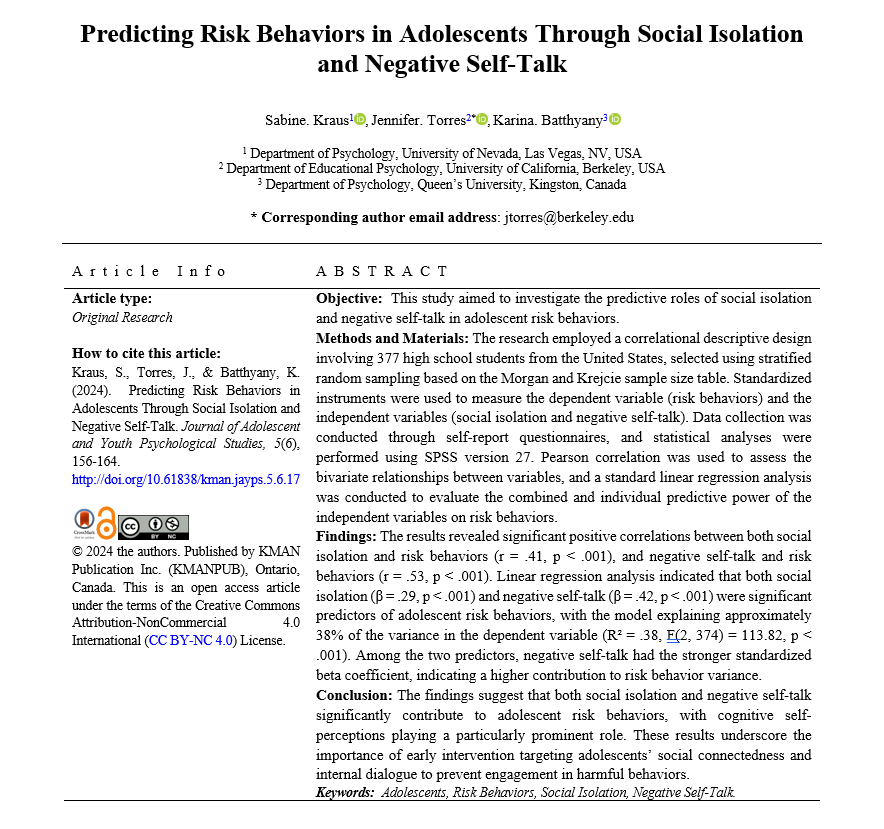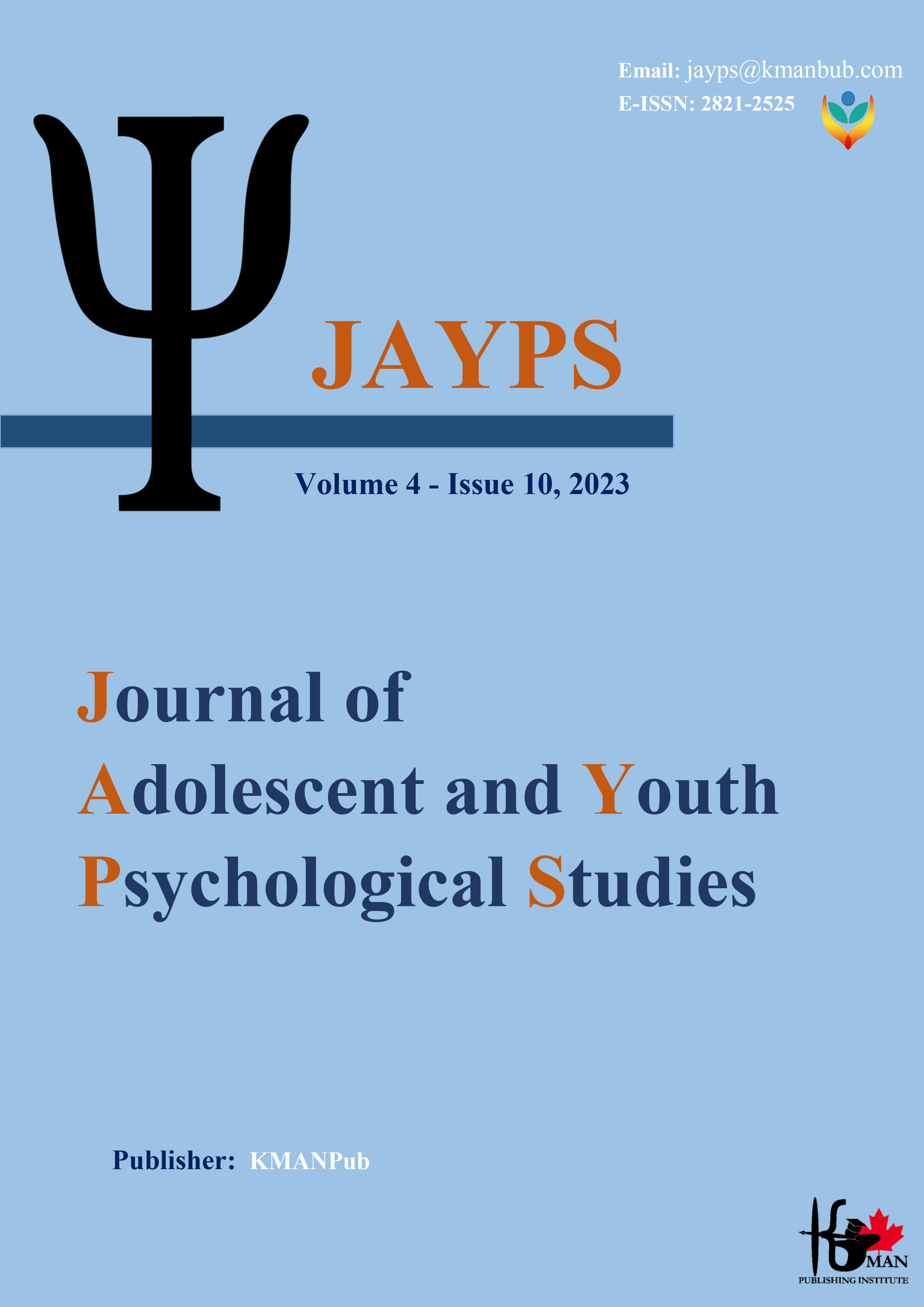Predicting Risk Behaviors in Adolescents Through Social Isolation and Negative Self-Talk
Keywords:
Adolescents, Risk Behaviors, Social Isolation, Negative Self-TalkAbstract
Objective: This study aimed to investigate the predictive roles of social isolation and negative self-talk in adolescent risk behaviors.
Methods and Materials: The research employed a correlational descriptive design involving 377 high school students from the United States, selected using stratified random sampling based on the Morgan and Krejcie sample size table. Standardized instruments were used to measure the dependent variable (risk behaviors) and the independent variables (social isolation and negative self-talk). Data collection was conducted through self-report questionnaires, and statistical analyses were performed using SPSS version 27. Pearson correlation was used to assess the bivariate relationships between variables, and a standard linear regression analysis was conducted to evaluate the combined and individual predictive power of the independent variables on risk behaviors.
Findings: The results revealed significant positive correlations between both social isolation and risk behaviors (r = .41, p < .001), and negative self-talk and risk behaviors (r = .53, p < .001). Linear regression analysis indicated that both social isolation (β = .29, p < .001) and negative self-talk (β = .42, p < .001) were significant predictors of adolescent risk behaviors, with the model explaining approximately 38% of the variance in the dependent variable (R² = .38, F(2, 374) = 113.82, p < .001). Among the two predictors, negative self-talk had the stronger standardized beta coefficient, indicating a higher contribution to risk behavior variance.
Conclusion: The findings suggest that both social isolation and negative self-talk significantly contribute to adolescent risk behaviors, with cognitive self-perceptions playing a particularly prominent role. These results underscore the importance of early intervention targeting adolescents’ social connectedness and internal dialogue to prevent engagement in harmful behaviors.
Downloads
References
Abbasi, M., Torabi, F., & Aghayari, A. (2020). Explaining the model of the relationship between self-talk in sports with sports motivation and sports anxiety in female student athletes in Hamedan. Psychology and Behavioral Sciences of Iran 1(26), 1-15. https://www.psyj.ir/afile/phpgcxTHL.pdf
Ağır, M. (2019). Factors Affecting Social Exclusion, Friendship Quality, Social Competence and Emotion Management Skills and the Effect of Problem Behaviors on Related Characteristics in Adolescents. Journal of Education and Training Studies, 7(10S), 24. https://doi.org/10.11114/jets.v7i10s.4508
Averdijk, M., Ribeaud, D., & Eisner, M. (2019). Childhood Predictors of Violent Victimization at Age 17 Years: The Role of Early Social Behavioral Tendencies. The Journal of Pediatrics, 208, 183-190.e181. https://doi.org/10.1016/j.jpeds.2018.12.056
Baramake, Z., Fadavi, M. S., & Yousefi, Z. (2024). Development of a Successful Intelligence Training Package Aimed at Reducing High-Risk Behaviors Especially for Teenagers. Journal of Psychological Dynamics in Mood Disorders (PDMD), 2(4), 101-114. https://doi.org/10.22034/pdmd.2024.444922.1054
Choi, J., Seo, M., Kim, J., & Kim, K. (2022). The Relationship of Risky Online Behaviors and Adverse Childhood Experiences to Online Sexual Victimization Among Korean Female Adolescents. Journal of interpersonal violence, 38(3-4), 3637-3660. https://doi.org/10.1177/08862605221109888
Dana, A., & Shams, A. (2022). The Structural Relationship between Coaching Behaviors, Self-Esteem, and Personality Traits with Self-Talk in Young Elite Athletes. Journal of Sports Psychology. https://doi.org/10.29252/mbsp.2023.230072.1183
Dou, K., Zhang, M. C., & Liang, Y. (2020). Adolescents’ Future Negative Time Perspective and Risk-Taking Behaviors: The Roles of Coping Styles and Self-Control. https://doi.org/10.31234/osf.io/rgcts
Dutertre, E. (2023). Post-Lockdown Loneliness and Social Isolation Among French Students. International Journal of Educational Management, 38(1), 21-39. https://doi.org/10.1108/ijem-03-2023-0119
Fox, R. S. (2023). Social Isolation and Social Connectedness Among Young Adult Cancer Survivors: A Systematic Review. Cancer. https://doi.org/10.1002/cncr.34934
Ha, T., Ryzin, M. J. V., & Elam, K. K. (2021). Socialization Processes Within Adolescents’ Relationships With Parents and Peers Predicting Couples’ Intimate Partner Violence in Adulthood: A Social Learning Perspective. Development and Psychopathology, 35(1), 204-217. https://doi.org/10.1017/s0954579421000602
Hanan, A. F., Kusmawati, A., Putri, T. E., & Oktaviani, T. (2024). Pentingnya Dukungan Sosial Terhadap Perilaku Self-Harm Pada Remaja Yang Merasa Kesepian. Concept Journal of Social Humanities and Education, 3(1), 211-218. https://doi.org/10.55606/concept.v3i1.998
Jia, X., Zhu, H., Sun, G., Meng, H., & Zhao, Y. (2021). Socioeconomic Status and Risk-Taking Behavior Among Chinese Adolescents: The Mediating Role of Psychological Capital and Self-Control. Frontiers in psychology, 12. https://doi.org/10.3389/fpsyg.2021.760968
Jusienė, R., Breidokienė, R., Sabaliauskas, S., Miežienė, B., & Emeljanovas, A. (2022). The Predictors of Psychological Well-Being in Lithuanian Adolescents After the Second Prolonged Lockdown Due to COVID-19 Pandemic. International journal of environmental research and public health, 19(6), 3360. https://doi.org/10.3390/ijerph19063360
Liang, Z., Dou, K., Li, J. B., Wang, Y., & Nie, Y. (2022). Linking Self-Control to Negative Risk-Taking Behavior Among Chinese Late Adolescents: A Moderated Mediation Model. International journal of environmental research and public health, 19(13), 7646. https://doi.org/10.3390/ijerph19137646
Lodha, J., Brocato, E. R., & Wolstenholme, J. T. (2022). Areas of Convergence and Divergence in Adolescent Social Isolation and Binge Drinking: A Review. Frontiers in Behavioral Neuroscience, 16. https://doi.org/10.3389/fnbeh.2022.859239
Longo, I., Orecchio, S., Mafodda, A. V., & Sorrenti, L. (2019). The Relationship Between Self-Endangering Behaviours, Hopelessness Depression and Perceived Social Support in Adolescence. Journal of Psychology and Psychotherapy Research, 6, 19-23. https://doi.org/10.12974/2313-1047.2019.06.4
Lorenzo‐Blanco, E. I., Meca, A., Unger, J. B., Szapocznik, J., Cano, M. Á., Rosiers, S. E. D., & Schwartz, S. J. (2018). Cultural Stress, Emotional Well-Being, and Health Risk Behaviors Among Recent Immigrant Latinx Families: The Moderating Role of Perceived Neighborhood Characteristics. Journal of youth and adolescence, 48(1), 114-131. https://doi.org/10.1007/s10964-018-0907-5
Owens, C. R., Codd, E. L., & Haskett, M. E. (2020). Risk-Taking Behaviors of Homeless Youth: Moderation by Parental Monitoring and Social Support. Journal of Children and Poverty, 26(2), 237-251. https://doi.org/10.1080/10796126.2020.1834804
Patterson, M. W., Pivnick, L., Mann, F. D., Grotzinger, A. D., Monahan, K. C., Steinberg, L., Tackett, J. L., Tucker‐Drob, E. M., & Harden, K. P. (2019). Positive Risk-Taking: Mixed-Methods Validation of a Self-Report Scale and Evidence for Genetic Links to Personality and Negative Risk-Taking. https://doi.org/10.31234/osf.io/bq63f
Permadi, D. A., & Dairobi, M. N. (2021). Self Esteem Dan Risk Taking Behavior Dengan Perilaku Narsistik Remaja Penggunan Media Sosial. Psycomedia Jurnal Psikologi, 1(1), 29-37. https://doi.org/10.35316/psycomedia.2021.v1i1.29-37
Pokhrel, P., Bennett, B. L., Regmi, S., Idrisov, B., Galimov, A., Ахмадеева, Л. Р., & Sussman, S. (2017). Individualism-Collectivism, Social Self-Control and Adolescent Substance Use and Risky Sexual Behavior. Substance Use & Misuse, 53(7), 1057-1067. https://doi.org/10.1080/10826084.2017.1392983
Ratnawati, D., Setiawan, A., Widyatuti, W., Hastono, S. P., Susanto, T., Asih, S. R., Siregar, T., & Pramono, R. A. (2024). Factors Influencing Adolescent Resilience and Human Immunodeficiency Virus-Acquired Immune Deficiency Syndrome Prevention Behavior: A Cross-Sectional Study of Adolescents in DKI Jakarta Province, Indonesia. The Open Nursing Journal, 18(1). https://doi.org/10.2174/0118744346330118240718035950
Shadur, J. M., Ninnemann, A., Lim, A. C., Lejuez, C. W., & MacPherson, L. (2017). The Prospective Relationship Between Distress Tolerance and Cigarette Smoking Expectancies in Adolescence. Psychology of Addictive Behaviors, 31(5), 625-635. https://doi.org/10.1037/adb0000300
Shariati, F. K., & Jamal. (2013). The Effect of Different Types of Self-Talk on Balance Performance in Healthy Elderly Individuals. Journal of Motor Development and Sports Learning, 5(13), 119-133. https://jsmdl.ut.ac.ir/article_32138.html?lang=en
Siriphadung, S. (2019). Intergenerational Transmission of Religiosity and the Reduction of Thai Adolescent Risk Behaviors. Journal of Population and Social Studies, 27(2), 139-152. https://doi.org/10.25133/jpssv27n2.009
Son, Y., Kim, S., & Lee, J.-S. (2021). Self-Injurious Behavior in Community Youth. International journal of environmental research and public health, 18(4), 1955. https://doi.org/10.3390/ijerph18041955
Thurman, T. R., Nice, J., Luckett, B., & Visser, M. (2018). Can Family-Centered Programing Mitigate HIV Risk Factors Among Orphaned and Vulnerable Adolescents? Results From a Pilot Study in South Africa. AIDS care, 30(9), 1135-1143. https://doi.org/10.1080/09540121.2018.1455957
Yadlosky, L. B., Mowrey, W. B., & Pimentel, S. S. (2023). Risky business: Considerations of emotion regulation and high-risk behaviors in anxious adolescents. Journal of anxiety disorders, 99, 102760. https://doi.org/10.1016/j.janxdis.2023.102760
Yu, Y., & Sun, H. (2024). Shyness and Self-Consistency and Congruence Among Chinese Adolescents: Mediating Role of Social Comparison Orientation and Moderating Role of Self-Focused Attention. Frontiers in psychology, 15. https://doi.org/10.3389/fpsyg.2024.1418123

Downloads
Additional Files
Published
Submitted
Revised
Accepted
Issue
Section
License

This work is licensed under a Creative Commons Attribution-NonCommercial 4.0 International License.








